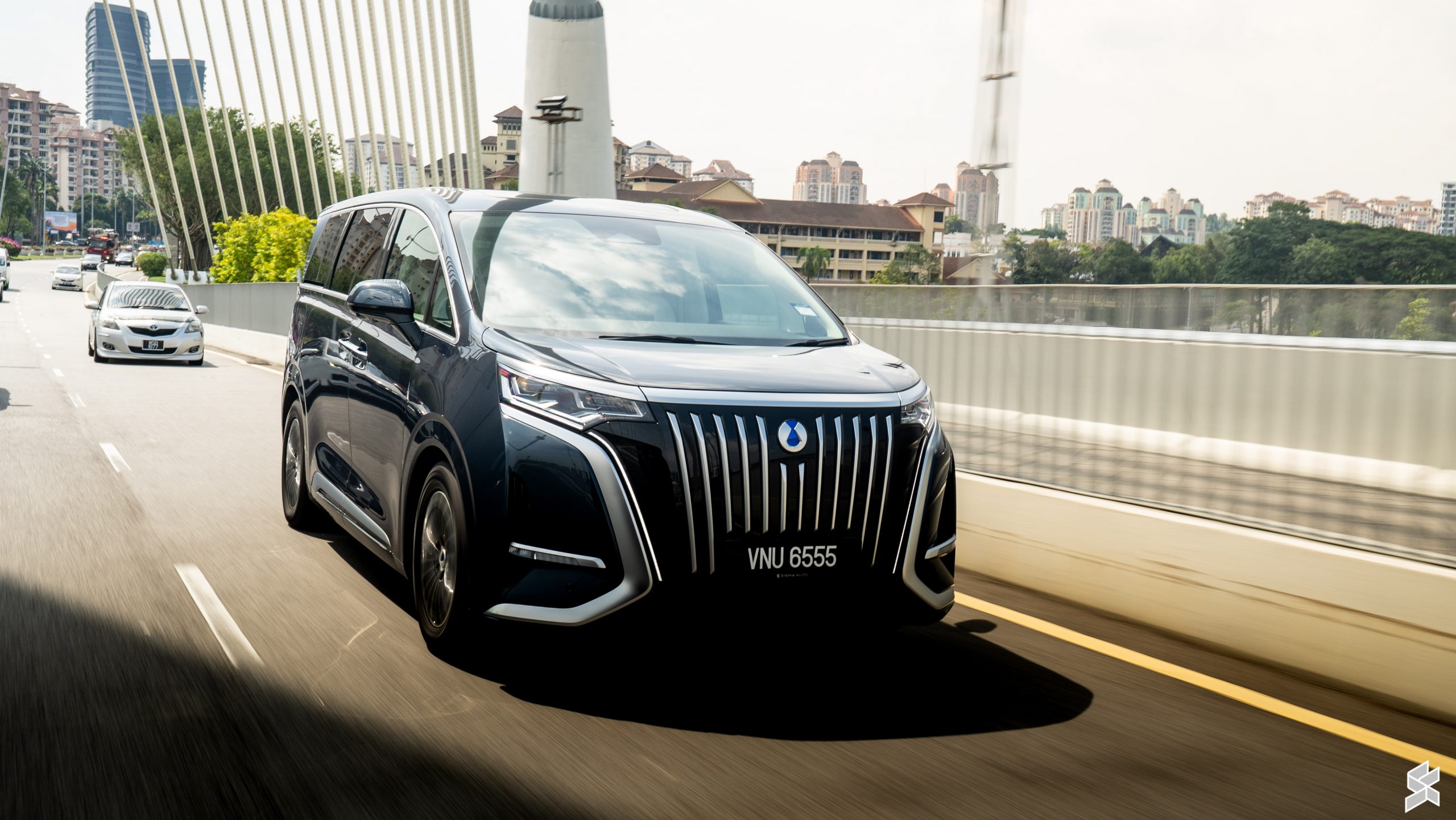Denza D9 Premium AWD Malaysia Review: Why bother with Alphard?
17 小时前
The Toyota Alphard has long reigned supreme as Malaysia’s king of luxury people movers but that dominance is now being challenged by a new wave of electric MPVs. Among the current lineup of premium electric MPVs is the Denza D9 that’s offered in both FWD and AWD variants.
Hailing from BYD’s premium brand, Denza, the D9 range-topping Premium AWD model is priced at a competitive RM309,000. Not only it is cheaper than a brand new Alphard, it takes aim at the recond market, promising more power, smoother and quieter experience, and it’s packed with more tech.
The Denza D9 Premium AWD is also currently Malaysia’s most affordable fully-electric, premium 7-seater MPV with an all-wheel-drive configuration. We drove this electrified behemoth from Kuala Lumpur to Johor Bharu to find out if it’s truly the Alphard killer we’ve been waiting for.
Design and Dimensions: Longer and wider than an AlphardThe Denza D9 is quite a large vehicle measuring 5,250mm long, 1,960mm wide, and 1,920mm tall, riding on a long 3,110mm wheelbase. In comparison, it is 4cm longer than the Zeekr 009 and about 20cm longer than the Alphard and Vellfire. It’s also wider than the Japanese MPVs by 10cm.
Among the three premium electric MPVs including the Zeekr 009 and Xpeng X9, the Denza D9 design seems conservative with a more traditional van-like appearance. In contrast, the 009 looks imposing with its boxy shape and bold grille, while Xpeng X9 looks overly futuristic like a space shuttle.
The standout design feature for the Denza D9 is its Transformer-like face which looks like a cross between the Nissan Serena and the Toyota Alphard. This AWD version also features an extended daytime running lights that flows from the edges of the headlamps downwards to the centre grille.
What I’m not the fan of is the vertical plastic slats on the front with matte finishing. I think it would have looked better if it was finished in chrome for a more metal-like appearance
The VIP Lounge: Cabin Tech and ComfortStepping inside, the Denza D9 offers a premium and spacious interior with the seats arranged in a 2+2+3 layout. Exclusive to the Premium AWD version are Nappa leather upholstery that’s offered in Beige combined with its suede headlining. The combination of contrasting materials and a light-coloured interior gives it a very airy and upscale ambience.
In addition, the Premium AWD variant also offers ventilated and massaging seats not just for the second row captain seats, but also for the front two occupants as well. On top of that, the top-spec variant also comes with a Head-up Display (HUD), complimenting its 10.25″ digital instrument cluster and a 15.6″ UHD infotainment display which supports Android Auto and Apple Car Play.
What I liked about the instrument cluster is that you can customise the widgets on both the left and right side of the screen. This includes the ability to display your Waze or Google Maps navigation on the instrument cluster itself. For audio, it gets a 14-speaker Dynaudio sound system which is pretty decent.
Unlike the Zeekr 009, I appreciate that the individual aircon vents can be adjusted manually and the centre console area comes with physical switches to control the powered sliding doors, fridge and tailgate. This makes chauffeur duties easier without the need to swipe around the touch screen.
The Denza D9 also offers a telescopic steering wheel but the controls are manual. What I do like is that the vital steering buttons are illuminated and laid out logically for ease of use. As you would expect from a BYD, the voice command system is very responsive and it is equally as good for the second row passengers.
The star of the show is the second row. These are not just seats; they are fully power-adjustable captain seats with 10-way control, complete with power-adjustable leg rests, and integrated massage functions that provides great comfort for long distance drives.
Each second-row occupants get a dedicated touchscreen on the armrests that provides controls for the seats, climate control, music playback, sliding doors, windows, roof shades, and ambient lighting literally at your fingertips. There are also rocker buttons on the sides that lets you make instant seat adjustments without fiddling around the touch screen.
There’s also manual privacy sunshades for the second row windows and individual aircon vents for both sides on the second and third rows. If you need more palces to store your items, there’s a retractable centre table with two cup holders.
But perhaps the most luxurious bit of kit is the built-in motorised refrigerator between the two front seats. It slides in and out automatically at the touch of a button and can cool drinks down to -6°C or even warm food up to 50°C, which is perfect for long distance travel.
Unlike the Zeekr 009 and Xpeng X9, the Denza D9 doesn’t come with a second fold down screen at the rear and there’s no extra cameras that you can use for zoom calls. But at least, the second row captain seats get side-mounted wireless charger and a USB-C port, and there’s also a sturdy fold down table attached behind the front seats. The only things missing to complete this MPV as a mobile office is a 230V power outlet or a 100W USB-C port to fast charge a laptop on the go.
In the third row, there’s ample of space for three passengers and there’s sufficient headroom and knee room, making this a comfortable place for long drives. You can fit three adults at a squeeze here but its best for two adults for interstate road trips. On each side, you get cupholders and USB-C port, plus individual aircon vents at the top.
Decent performance, quiet ride but ADAS needs improvementThe Denza D9 Premium AWD’s dual-motor is no slouch as it has an all-wheel-drive setup delivering 275kW (369hp) and 470Nm of torque. This 2.8 tonne vehicle is capable of a 0-100km/h acceleration time of 6.9 seconds. While the power figures look impressive, don’t expect neck breaking acceleration as power is delivered gradually for a comfort-oriented experience.
It doesn’t rocket like the Zeekr 009 but the gradual acceleration is definitely something your passengers would appreciate.
In terms of suspension, the Denza D9 doesn’t get front double wishbones and air suspension like its other electric rivals. It gets MacPherson struts for the front and multi-link suspension setup for the rear.
For the AWD model, the Denza D9 features BYD’s DiSus-C Intelligent Damping Body Control System with adaptive dampers which are desigend to actively minimise body roll and to optimise ride comfort. On the Comfort setting it does help to cushion imperfections but it is overly soft. It tends to wobble on uneven surfaces which can be annoying if you’re driving around residential areas with lots of speed humps. We ended up leaving the suspension settings to Sports which firms up the ride and it felt more settled over uneven roads.
What needs to be highlighted is Noise, Vibration and Harshness (NVH) of the cabin. With double glazed glass on all windows, the Denza D9 offers a very quiet ride and it does a very good job of isolating unwanted noise from your surroundings. At national highway speeds, there’s minimal wind and tyre noise, and the only thing noticeable is the sound of the aircon during hot weather.
As you would expect from an EV, it packs a comprehensive safety feature list including eight airbags, four ISOFIX points and a full suite of Advanced Driver Assistance Systems (ADAS). The Premium variant gets extra features including Forward Traffic Crossing Alert/Braking, and Driver Fatigue/Distraction Monitoring.
The Intelligent Cruise Control is easy to activate and you can adjust the distance easily from the dedicated buttons on the steering wheel.
If you’ve driven BYDs in the past, you’ll know that the driver assist features can get pretty aggressive, as if someone is yanking the steering wheel. On the Denza D9, we are happy to report that the aggressiveness of the system has toned down significantly but you can still feel the steering being tugged when you make a slight correction when lane centering assist is enabled.
The ADAS feature works as intended but it can be refined further for a smoother and confident drive. The D9 also comes with a 360 degree camera and by default, it shows the side camera view while making a turn. This is useful when driving through tight spaces, which is something you need when driving a vehicle this long.
Another interesting feature is the digital rear view mirror. On paper, it sounds like a good feature to have to get a good view of the back while having loads of passengers at the back. However, the glare of the surface itself is so distracting that eventually we stick to the good old fashion mirror and 360 degree camera instead.
Decent range and underclaimed DC charging speedsThis electric MPV comes with a rather large 103.36kWh Blade LFP battery pack. With the AWD model, it gets a lower WLTP-rated range of 480km versus 520km on the Advanced FWD variant.
During our road trip from Kuala Lumpur to Johor Bahru on a Friday night, we left Kuala Lumpur at 10:30pm with 100% charge, and we arrived in Johor Bharu at 2:18am on a single charge with 19% battery remaining. In total, we covered a distance of 328km in 3 hours and 48 minutes and that includes a quick toilet break at Machap R&R.
Based on what we’ve observed, the Denza D9 is quite thirsty at highway speeds with an average consumption between 23-25kWh per 100km. That’s higher than the typical 21-23kWh per 100km efficiency we got on our recent 7-seater electric MPV/SUV tests. The higher consumption is probably due to its less aerodynamic shape, after all, Denza didn’t disclose the D9’s drag coefficient figures.
But with a battery this size, there shouldn’t be any problem making the typical KL to Penang and KL to Johor Bahru trip on a single charge if you’re driving sensibly within the national speed limit. And in most cases, you’ll definitely make a toilet stop in between, which is also a good opportunity to do a quick 15-minute top up.
However, when it comes to city driving, the D9 is fairly efficient and we could easily get between 17-18kWh per 100km. Based on that, we reckon it is possible to get close to the WLTP-rated range figures for chauffeur duties in the city or the usual school runs.
The Denza D9 supports the standard 11kW three-phase AC charging and up to 166kW DC fast charging. When we charged at Gentari’s 240kW DC Charger at Petronas KLIA, it took 37 minutes to charge from 18% to 80% (70.2kWh) with a peak rate of 165kW.
However, we noticed that the D9 could charge much faster on a DC Charger with higher current. During our EV Track Day, we got a peak rate of 174kW on a 180kW DC Charger with 300A, and it took 15 minutes to top up from 24 to 49% (37kWh).
We’ve also seen the Denza D9 getting over 200kW when it was charged at eLoaded’s DC Charger at Johor Premium Outlets.
Why bother with a recond MPV?The Denza D9 Premium AWD offers an impressive value proposition in the premium MPV space. For RM309,000, you are not just getting a new vehicle with official local warranty, you are getting more power, superior cabin quietness, more tech features including a fridge and lower running costs compared to any equivalent recond Alphard or Vellfire.
Besides less maintenance, having an EV allows you to enjoy lower running cost if you can charge it up at home and it gets even better if you have solar on the roof. Just plug in when you get home, and you can start the next day with more than sufficient range. In addition, it also supports Vehicle-to-Load (V2L), allowing you to convert this MPV as a power bank to power up home appliances.
It may not have the performance of the Zeekr 009 or the efficiency and quick charging capabilities of the Xpeng X9, but this Denza MPV remains the most popular fully electric MPV in the market today. Based on the latest JPJ data, there are over 850 Denza D9 registered in Malaysia up to September 2025.
If you’re looking for a more affordable alternative, there’s the Advanced FWD model priced at RM259,000. Besides having less power (230kW / 308hp), and a slower 0-100km/h time of 9.5 seconds, take note that you do lose out on several creature comfort features. This includes massaging front seats, HUD, no DiSus-C adaptive damping, no Nappa leather and no suede headlining. In addition, the Advanced FWD model also lacks several ADAS features including Forward Traffic Cross Alert and Cross Braking as it has a few sensors less.
...Read the fullstory
It's better on the More. News app
✅ It’s fast
✅ It’s easy to use
✅ It’s free









